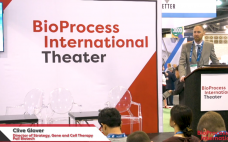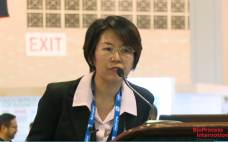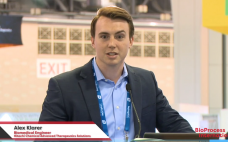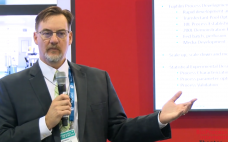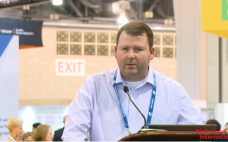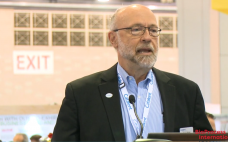Clive Glover, director of strategy for gene and cell therapy at Pall Biotech, presented at the BPI Theater at BIO on Tuesday, 4 June 2019, about how questions of manufacturing scale will dictate new developments and investments in gene therapy technologies. For this reason, Glover added, Pall strives to find ways of reintegrating extant technologies for optimal manufacturing scale. Once a drug sponsor and Pall reach consensus about process parameters, Pall initiates an integrated solutions design that helps it and…
Sponsored Content
Your Success to IND and BLA, Faster and Better
In this BPI Theater at BIO presentation, delivered on Wednesday, 5 June 2019, Eun Young Yang, executive director and head of the CSO business team at Samsung Biologics, explained how the firm’s end-to-end service increases the chance of commercial success for investigational new drugs (INDs). In addition to fully integrated development and manufacturing services for IND filing, Samsung offers regulatory expertise that can usher sponsoring organizations through clinical trials for monoclonal antibodies (MAbs), fusion proteins, bispecific antibodies, and multispecific antibodies…
Single-Use Stirred-Tank Bioreactors: A Commercially Viable Strategy for Cell Therapy Manufacturing
Representing Hitachi Chemical Advanced Therapeutic Solutions, Alex Klarer spoke to the BPI Theater at BIO on Tuesday, 4 June 2019, about ways to improve patient access to revolutionary T-cell immunotherapies. A feasible solution, Klarer contended, is to develop a form of stirred-batch bioculture that reduces the entire manufacturing process while still maintaining high expansion rates with low media use. To establish this as a possibility, Klarer described his firm’s experiments with small and large batches on a Distek cell culture…
Process Development of a Closed CAR-T Manufacturing Process
Representing GE Healthcare, Rohin Iyer joined BPI Theater at BIO on Tuesday, 4 June 2019, to explore how academic and clinical drug sponsors could partner with service providers to develop bioprocesses more akin to those in the industry at large. Iyer chronicled GE’s collaboration with the non-profit Center for Commercialization of Regenerative Medicine (CCRM), a public–private partnership in which a team of 105 people (both GE Healthcare and CCRM employees) work together at one location. Elaborating this example, Iyer pointed…
Reliable Supply Network with the Highest Quality Performance, the Most Stringent Change Management and Built-In Business Continuity for Single-Use Supplies
This webcast features: Claudio Catallo, Head of Global Supply Chain and Optimization Network Strategy Execution for Fluid Management Technology Operations Unit at Sartorius Stedim Biotech, and Elisabeth Vachette, Head of Product Management for Bags/Mixing/Tanks within the Single Use Fluid Management Technologies Department at Sartorius Stedim Biotech Single-use system implementation is increasing at a steady rate, recognizing the huge benefit of disposable material in biotechnology processes, providing safer, greener, cheaper and more flexible drug manufacturing processes. Our unique expertise in global…
Blockbuster 2.0: Who’s Ready?
During a BPI Theater at BIO presentation on Wednesday, 5 June 2019, Charles Christy, director of commercial development at Ibex Solutions (Lonza Pharma and Biotech), considered the increasing speed of molecule discovery, process development, and clinical approval in the biopharmaceuticals industry. Weighing the promises and pitfalls of such a volatile, uncertain market, Christy offered drug developers advice about when to build biomanufacturing facilities in-house and when to outsource services. One solution, Christy suggests, is to partner with agile contract development…
Quality Considerations for Introducing New Products into Your Facility
Ray Marzouk, vice president of quality at Avid Bioservices, joined the BPI Theater at BIO on Wednesday, 5 June 2019, to call out factors that drug developers often neglect when they are deciding whether to enlist a contract development manufacturing organization (CDMO) for scaling up and introducing new therapies in a competitive market. Citing examples related to ICH Q5d cell banking rules, Marzouk explained how Avid conducts smooth and rapid transfers of key process elements and quality diagnostics. Streamlining that…
Next-Generation Manufacturing for Biopharmaceuticals
In this BPI Theater @ BIO presentation from Tuesday, 4 June 2019, Thomas Page, a vice president of engineering and asset development, explains how Fujifilm Diosynth partners with other organizations to deliver commercial-quality chemistry, manufacturing, and controls (CMC) for complex, next-generation biopharmaceuticals. Rather than simply transacting with clients, Page notes, his firm elects to go beyond standard engineering controls for patient safety and clinical filing. Using a wider array of risk assessments than is typical in the industry enables Fujifilm…
The Cocoon Platform: A Kaleidoscope Approach to Cell Therapy Manufacturing
Matthew Hewitt, the head of clinical development at Lonza’s Walkersville headquarters, unveiled the company’s Cocoon platform at the BPI Theater @ BIO on Tuesday, 4 June 2019. Scalable, fully closed, single-use–capable, and intuitively interfaced, the platform offers what Hewitt terms a kaleidoscope approach to cell therapy manufacturing because it enables drug developers increased ability to customize their processes. The technology also addresses many pain points specific to the cost of cleanroom space, labor, and scalability. These exciting features, Hewitt concludes,…
Cell Line Development Strategies for Difficult-to-Express Proteins
Steven Hager, a senior director of technical support, joined the BPI Theater at BIO on 5 June 2019 to describe how Catalent Biologics’s emerging cell-line engineering technologies can aid in developing therapies based on difficult-to-express proteins. Hager presented two case studies to this end, the first involving insertion of a tag into an antibody for conjugation with a toxin to create an antibody–drug conjugate (ADC), and the second showing another antibody with two sites for conjugation on each chain. Using…

